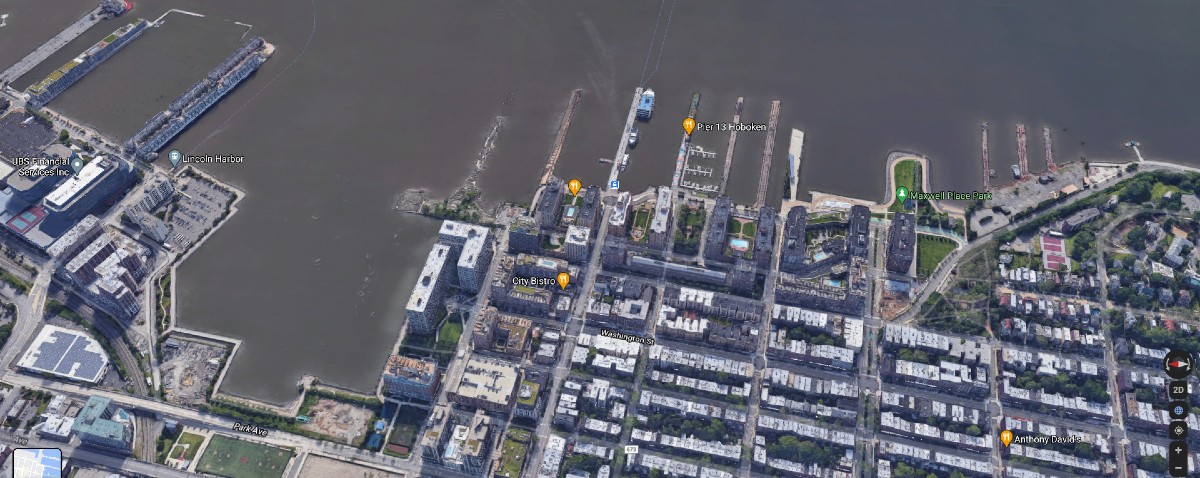Although much of the lower Hudson River has a man-made bulkhead–a hard edge–protecting the shoreline from erosion, the Weehawken and Hoboken Coves provide unique opportunities to maintain “living shorelines,” natural areas where native vegetation such as eelgrass and saltwater cordgrass could grow.
The Hoboken Cove has a natural sand beach, the only one on either side of the Hudson River south of the George Washington Bridge. The Weehawken Cove is an inlet, protected from the powerful currents of the Hudson River.
Hoboken resident and biologist Noelle Thurlow has found ribbed mussels growing wild, attached to the riprap, the stones put down to stabilize the shoreline at both coves. She has also identified an array of shorebirds at the Weehawken Cove such as mallards, mergansers, brant geese and boat-tailed grackles. At the Hoboken Cove, and among the piers to the north, she has found additional shorebirds such as the common tern, the herring gull, bank swallows, great blue heron and osprey. Ms. Thurlow has spotted shark-eye snails, blue crabs and black-fingered mud crabs along this stretch of Hoboken’s northern waterfront.
Of course, there are also multitudes of fish found there as well, denizens of the lower Hudson River. Many, such as striped bass, American shad, American eel and Atlantic sturgeon are migratory, traveling between the Hudson River and the Atlantic Ocean. The Weehawken Cove and Hoboken Cove provide protected waters, an inviting habitat and nesting ground for much of this biodiverse wildlife.
The Hoboken Cove is one of the most popular locations in the lower Hudson River for the public to get into the river via kayak, outrigger canoe or stand up paddleboard. It is the home of the Hoboken Cove Community Boathouse and the Ke Aloha Outrigger at the Hoboken Cove. The City of Hoboken has plans for another boathouse for human-powered craft at the Weehawken Cove, as part of the new four-acre Rebuild by Design flood mitigation park.
Thurlow, who owns Resilience Paddle Sports at Pier 13 on Hoboken’s north waterfront, co-authored a study in 2019, Restoring the Ecosystem of the Hoboken Cove, that concluded “Hoboken Cove/Union Dry Dock, Weehawken Cove and possibly Sinatra Park on a smaller scale are waterfront areas that support biodiversity” and should be targeted for ecosystem restoration.
Ecosystem restoration, living shorelines, shellfish reefs and public access to the waterfront are all goals of a comprehensive master plan to revive the New York-New Jersey Estuary. For countless years, this estuary has been under assault from surface runoff, municipal sewage and dumping of industrial chemicals. The passage of the federal Clean Water Act in 1972 marked a turning point for waterways across the nation.
In 1987, the federal government created the National Estuary Program. The following year, the New York-New Jersey Estuary became part of this program. The Army Corps of Engineers, in partnership with the Port Authority of New York and New Jersey, and the New York-New Jersey Harbor and Estuary Program, developed a series of studies and plans to guide ecosystem restoration. Protecting habitat for fish, shorebirds and marine life was a key goal. The plans targeted wetlands, coastal forests, oyster reefs and eelgrass beds for rehabilitation. It also recommended protecting ecologically valuable coastal lands from future development through land acquisition. Enhancing public access to the waterfront was also an essential goal of the program.
The Army Corps’ 2016 Hudson-Raritan Comprehensive Restoration Plan cites the importance of the lower Hudson River as a tidal estuary for the spawning and overwintering of migratory fish and reviving shellfish beds. Both the Weehawken and Hoboken Coves meet nearly all of the decision-making criteria of the Nature Conservancy for the restoration of living shorelines.
The Fund for a Better Waterfront (FBW) has worked closely with the City of Hoboken and other partners to secure the Union Dry Dock property for a public park. This three-acre site comprises the southern portion of the Hoboken Cove where NY Waterway and NJ Transit sought to locate a ferry refueling and repair facility.
After nine years of litigation, the City of Hoboken is negotiating a settlement to relocate two planned high-rise residential towers proposed for construction on a pier jutting northward into the Weehawken Cove. This portion of the waterfront could then be preserved as a park, thus connecting another portion of the continuous public waterfront park, first proposed by FBW in 1990.
Related Documents
Comprehensive Restoration Plan – Exec. Summary
Restoring the Ecosystem of the Hoboken Cove
Biodiversity of Hoboken Waterfront
Related Links
The life and potential death of the Hoboken Cove
The Billion Oyster Project harnesses the oyster’s unique ability to restore
3,000-year old outrigger canoe tradition lives on at the Hoboken Cove
City to make offer to buy Union Dry Dock
FBW appeals approvals for high-rise development at Weehawken Cove
Final legal dispute over Monarch Towers reaches the NJ Supreme Court



